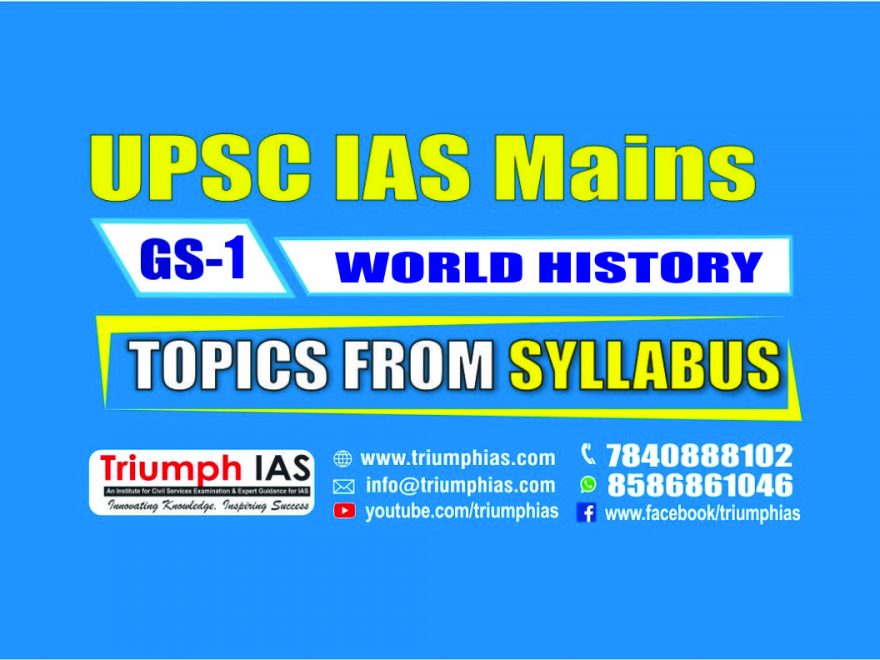Relevance: mains: G.S paper I: World History
Putting an end to the medieval age, the Renaissance blew the trumpet of modem age.
In the fifteenth century A.D. people of Europe developed interest for the literature, art, architecture, painting and culture of Greece and Rome.
The beacon light of Renaissance which first appeared in Italy travelled to other countries of Europe in due course of time. The expanded horizon of human knowledge was reflected in various fields including art, literature and science.
Meaning of Renaissance:
‘Renaissance’ means ‘Rebirth’ or ‘New Birth’. Analysed from the point of history, ‘Renaissance’ means the love, eagerness and interest which were shown towards the art and literature of Greece and Rome in the fifteenth century A.D. In medieval times, the Church regulated education and cast its influence upon the society. When human mind wanted to be free from that bandage and welcomed new light. Renaissance took place.
Causes of Renaissance:
There were many causes behind ‘Renaissance’. The fall of Constantinople was its main cause. It was the centre of learning. Although, it was under the clutches of the Christians, many Greek scholars were living there. They became famous by teaching Greek language and literature to the people.
In 1453 A.D., Muhammad II of Ottoman Empire occupied Constantinople and devasted it. Out of fear, the Greek intellectuals left Constantinople and entered into different cities of Italy like Venetia, Milan, Naples, Sicily, and Rome etc. They taught mathematics, history, geography, philosophy, astronomy, medicine etc. to the people of Italy. This gave birth to Renaissance.
Secondly, the invention of printing machine was responsible for Renaissance. In 145 A.D. John Gutenberg of Germany invented printing machine and letters and printed book. William Caxton brought this machine to England in 1477 A.D. With the march of time, printing machines were established in Italy, France, Belgium and other European countries. Thus, books could be published very easily with a short span of time. People could easily get books for study and learnt many things. This galvanised Renaissance.
Thirdly, many kings, nobles and merchants encouraged new literature and art. Francis I, the ruler of France, Henry VIII, the king of England, Charles V of Spain, Sigismund I, the king of Poland invited many persons having new ideas to their courts and patronised them. Loronjo-de-Medicci, the ruler of Florence invited many artists to his court and decorated his palace with new paintings. The progressive idea of these rulers galvanised Renaissance.
Finally, the men with new thoughts paved the way for Renaissance. They advised not to accept anything blindly which is not proved properly. Peter Abelard of the University of Paris inspired his contemporaries to create enthusiasm among themselves for research. He advised his students not to accept any doctrine blindly as God’s version.
They should accept anything if it is convinced by reason. His book ‘Yes and No’ inspired the youths as it revealed the defects of church system. He was compelled by Christian Priests to withdraw his view and he did it.
Another wiseman of the time was Roger Bacon of Oxford University who said that nothing should be accepted without proper experiment and observation. He had to spend some years in the Church prison because of his radical view. Thus, these persons with new ideas paved the way for Renaissance.
Results of Renaissance:
The results of the Renaissance were far reaching. This gave birth to new literature, art and science.
Literature:
The Renaissance literature had its birth in Italy. The first notable creation in this direction was Dante’s ‘Divine Comedy’. This book was written in Italian language and it was meant for the common people. In the book he describes about the heaven, hell and the other world. It introduced new themes like love of one’s country, love of nature as well as the role of individual.
Another pioneer of Renaissance thought was Francesco Petrarch. The medieval thought was monastic, ascetic and other worldly. In contrast, Petrarch glorified the secular or Worldly interests of life and humanism through his ‘Sonnet’, a form of poetry. His notable works were ‘Familiar Letters’ and ‘Lovers of Illustrious Man’. Another great writer of Italy during that period was Boccaccio.
In his world famous book ‘Decameron’ (Ten Days), he denounced God which brought a revolutionaiy change in the Christian World. The famous philosopher of Italy was Machiavelli who in his famous book ‘The Prince’ described the principle of the ‘Lion and the Fox’. Aristo’s ‘Orlandofuriso’ and Tasso’s ‘Jerusalem Delivered’ were two other great works for the Italian literature.
In other countries of Europe different kind of humanism spread in Renaissance period. In England Thomas Moore’s ‘Utopia’, Milton’s ‘Paradise Lost’ and ‘Paradise Regained’ were very famous which were created during this period. During Renaissance, William Shakespeare, the great playwright of England became famous for his plays like ‘Julius Caesar’, ‘Othello’, ‘Macbeth’, ‘As you Like it’, ‘Romeo and Juliet’, ‘Hamlet’, ‘Merchants of Venice’, ‘King Lear’, ‘Mid-summer Night’s Dream’, ‘The Tempest’ etc. Christopher Mario of England wrote his famous drama ‘Doctor Frastress’.
During this period, the Spanish writer Cerventis ‘Don Ruixote’ the works of Lope de Vaga and Calderon were very famous. By this time Martin Luther of Germany translated the ‘Bible’ into German language. The writings of famous Dutchman Desiderious Erasmus like ‘In Praise of Folly’, ‘Handbook of a Christian Soldier’ and ‘Familiar Colloquies’ gave new dimension to the literature. Robelai’s ‘Ganganchua’ and the writings of Racine, Sevigne and La Fontain created ‘Golden Age’ in the French literature. The Portuguese writer Camoen’s ‘Lusaid’ was admired by the people to a great extent.

